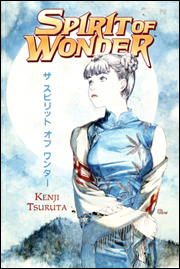DRAWN & QUARTERED
Adventure inspires spirit of loathing
When Jason, my partner in anime fandom, previewed this article in his "Cel Shaded" column last week, he said I'd be writing about "Spirit of Wonder," and that was all he knew.
After reading the manga by Kenji Tsuruta and watching the anime brought out by Bandai, that's pretty much all I know, too.
 DARK HORSE COMICS
The character, Miss China, doesn't offer much depth to "Spirit of Wonder" with her stereotypical Chinese accent and her penchant for fits of rage.
|
|
"Spirit of Wonder" is one of those older titles that you sometimes stumble upon while digging through the shelves at Jelly's. This single volume was published stateside by Dark Horse Comics/Studio Proteus in 1998 in American right-to-left format.
The collection of short stories that comprise "Spirit of Wonder" follow Miss China, the sexy Chinese owner of Ten-Kai Restaurant in 1950s Bristol, England, and her two aspiring-inventor boarders, young Jim Floyd and elderly Professor Breckenridge. Considering the men's "profession," they naturally are broke for a good part of the time, and when they're not busy trying to perfect some new gadget, they're trying their hardest to avoid Miss China's demands for payment of back rent -- usually accompanied by a good kick or two from the almost eternally angry martial artist.
The concept might seem familiar: wacky old mad scientist and his young, foolish apprentice create devices that go hilariously amiss and blow up the second floor of Ten-Kai every other day. But here you would be wrong. While roof-shattering explosions do occur occasionally, the twist is that Jim and Breckenridge's gizmos actually work -- they just suffer from the old man's shoddy promotional skills.
Still, even with all the cool contraptions, there's very little "wonder" here. The preconceived notion of "mad scientist" lingers even after the machines are shown to function. And the realism and detail in Tsuruta's beautiful artwork take it out of the slapstick genre and into the realm of more serious science fiction, so it's hard to accept the men's inventions as deliberately wacky devices meant to amuse with their inconceivability. Then, the seeming anachronism of the setting and characters isn't easy to wrap your head around.
When all that's not coming into play, there's Miss China's over-the-top rage and insistence on rent payments that kill nearly all possibility for any doe-eyed wonder on her part. And her stereotypical broken English is simply wearying from the start.
As for the "Spirit of Wonder" anime, there have been two releases: the first, subtitled "Miss China's Ring," brought out by AnimEigo in the early 1990s, and the second from Bandai called simply "Spirit of Wonder."
The second is the only one I've been able to get my hands on. While the first assumedly focuses on the corresponding story in the manga, the second is a series of original stories. The two episodes that involve Miss China and her two boarders follow the more common formula of inventions that don't quite go as they're expected to. In these, the restaurateur has almost none of the crazed, moody anger that dominates her manga character and is more of a happy-go-lucky Chinese girl who calmly accepts the unanticipated effects of the inventions.
The other episodes, contained in a two-parter called "Scientific Boys Club," are about three young boys growing up in the early 1900s in Bristol and their dream to go to Mars. Some 50 years have passed since that time, during which they've been busy making their dream into a reality.
Now old men, the trio celebrate the club's five decades by actually going to Mars. For this, they shanghai a club member's daughter, a scientist named Windy who came up with a theory of currents of ether that flow through the universe. It is her theory -- and the assumption of its truth -- upon which the Boys Club plans to get to Mars.
If you can get past the first five long minutes of the first episode of "Boys Club" that plays out like, as someone once put it, an animated C-SPAN, you'll be rewarded with another 25 minutes and another episode during which you'll really need to suspend your disbelief. The boys' -- sorry, men's -- vision seems like a pipe dream, but they actually do go to Mars. As in, they physically land on the Red Planet. Using a zeppelin.
Don't ask. And don't watch.
"Boys Club" does have one tiny saving grace. A scene at the end of the second episode that links the C-SPAN-like beginning to the Bristol endeavor has an ironic humor that almost makes up for the rest of the episodes. Almost.
The anime also almost manages to inject some sliver of "wonder" back into the ambitious title. But, in contrast to the manga, there's too much outlandishness to take it seriously. (I mean, really -- a zeppelin? With enough power to break Earth's gravitational force?)
"Spirit of Wonder" the manga might be the more enjoyable of the two for pure absurdity alone. But both the anime and manga swing back and forth between stupidity and science, leaving the audience disoriented and wondering what's up.
And that's about the only kind of "wonder" that "Spirit of Wonder" manages to evoke.

